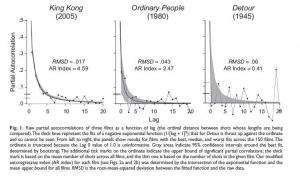February 19, 2010 report
Hollywood movies follow a mathematical formula

(PhysOrg.com) -- Hollywood movies have found a mathematical formula that lets them match the effects of their shots to the attention spans of their audiences.
Psychologist Professor James Cutting and his team from Cornell University in Ithaca, New York, analyzed 150 high-grossing Hollywood films released from 1935 to 2005 and discovered the shot lengths in the more recent movies followed the same mathematical pattern that describes the human attention span. The pattern was derived by scientists at the University of Texas in Austin in the 1990s who studied the attention spans of subjects performing hundreds of trials. The team then converted the measurements of their attention spans into wave forms using a mathematical technique known as the Fourier transform.
They found that the magnitude of the waves increased as their frequency decreased, a pattern known as pink noise, or 1/f fluctuation, which means that attention spans of the same lengths recurred at regular intervals. The same pattern has been found by Benoit Mandelbrot (the chaos theorist) in the annual flood levels of the Nile, and has been seen by others in air turbulence, and also in music.
Cutting made his discovery by measuring the length of every shot in 150 comedy, drama and action films, and then converted the measurements into waves for every movie. He found that the more recent the films were, the more likely they were to obey the 1/f fluctuation, and this did not just apply to fast action movies. Cutting said the significant thing is that shots of similar lengths recur in a regular pattern through the film.
Cutting believes obeying the 1/f law makes films “resonate with the rhythm of human attention spans,” and this makes them more gripping. Films edited in this way would then tend to be more successful and the style of shooting and editing more likely to be copied. Films of Cutting’s own favorite genre, the Film Noir, do not generally follow the 1/f law, with shot lengths tending to be more random. By contrast The Empire Strikes Back (1980) and the 2005 blockbuster movie Star Wars Episode III (which Cutting considers to be “just dreadful”) both follow 1/f rigidly.
The researchers concluded that over the next few decades film makers may take more care to follow the 1/f law to try to boost audience engagement.
More information: Attention and the Evolution of Hollywood Film; James E. Cutting, Jordan E. DeLong and Christine E. Nothelfer, Psychological Science published online 5 February 2010. DOI:10.1177/0956797610361679 . Full text of the paper is available here.
© 2010 PhysOrg.com

















